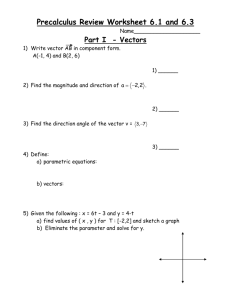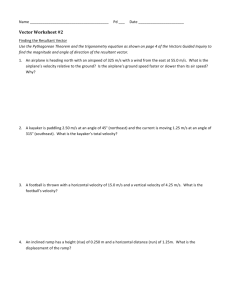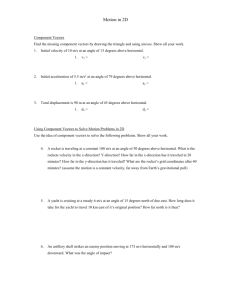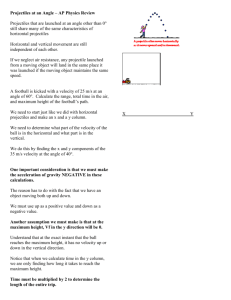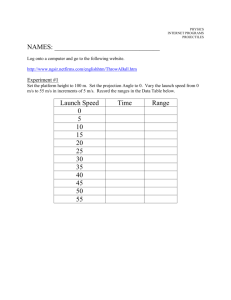Introduction - White Rose Research Online
advertisement
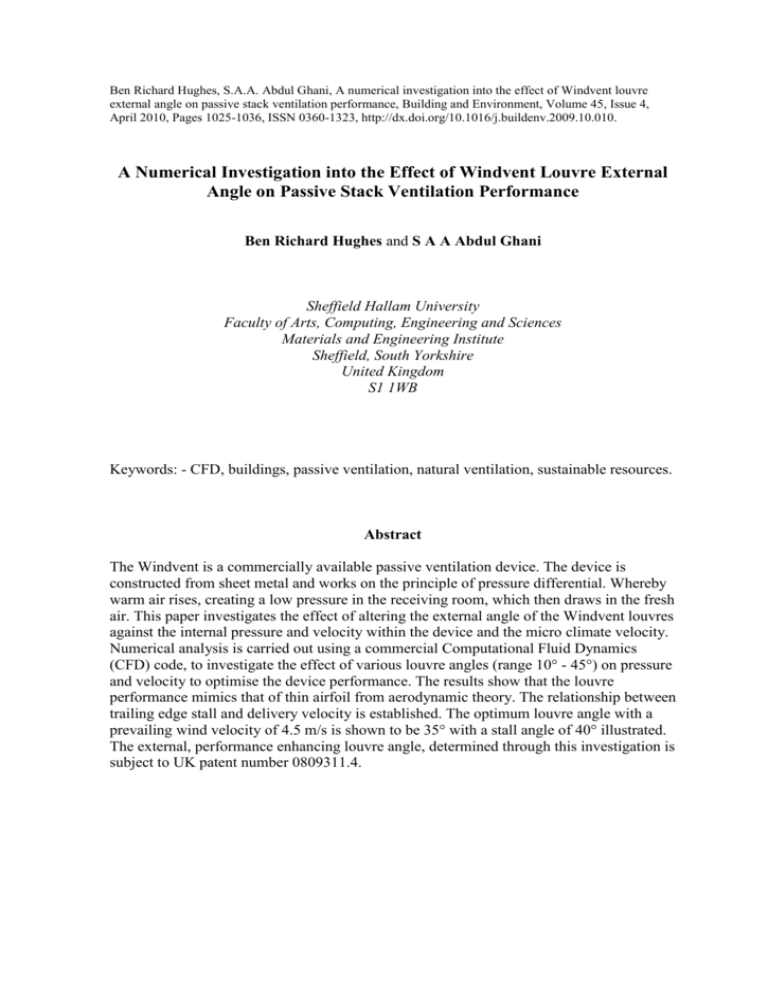
Ben Richard Hughes, S.A.A. Abdul Ghani, A numerical investigation into the effect of Windvent louvre external angle on passive stack ventilation performance, Building and Environment, Volume 45, Issue 4, April 2010, Pages 1025-1036, ISSN 0360-1323, http://dx.doi.org/10.1016/j.buildenv.2009.10.010. A Numerical Investigation into the Effect of Windvent Louvre External Angle on Passive Stack Ventilation Performance Ben Richard Hughes and S A A Abdul Ghani Sheffield Hallam University Faculty of Arts, Computing, Engineering and Sciences Materials and Engineering Institute Sheffield, South Yorkshire United Kingdom S1 1WB Keywords: - CFD, buildings, passive ventilation, natural ventilation, sustainable resources. Abstract The Windvent is a commercially available passive ventilation device. The device is constructed from sheet metal and works on the principle of pressure differential. Whereby warm air rises, creating a low pressure in the receiving room, which then draws in the fresh air. This paper investigates the effect of altering the external angle of the Windvent louvres against the internal pressure and velocity within the device and the micro climate velocity. Numerical analysis is carried out using a commercial Computational Fluid Dynamics (CFD) code, to investigate the effect of various louvre angles (range 10° - 45°) on pressure and velocity to optimise the device performance. The results show that the louvre performance mimics that of thin airfoil from aerodynamic theory. The relationship between trailing edge stall and delivery velocity is established. The optimum louvre angle with a prevailing wind velocity of 4.5 m/s is shown to be 35° with a stall angle of 40° illustrated. The external, performance enhancing louvre angle, determined through this investigation is subject to UK patent number 0809311.4. 1.0 Introduction The ventilation of buildings is an essential design consideration for reasons of Health and safety. The minimum recommended fresh air requirements for buildings are set out in British Standards (BS) and are applicable depending on the intended usage and occupancy levels. There are two main categories for ventilation strategies, namely mechanical and natural. Natural ventilation relies on the external wind conditions to deliver the required fresh air supply with BS5925:1991 [1] setting out the minimum fresh air requirements for naturally ventilated buildings. There are many strategies and devices for natural ventilation; one common device is a natural ventilation stack. The stack device sits at the top of the building or room and acts as both an inlet and extract. With warm air rising from the room and exiting through the stack a negative pressure is created in the receiving room and draws in the external fresh air supply. The flow of air through the device is further assisted by the windward and leeward pressures exerted on it by the external wind speed. The rate at which the flow is delivered to the receiving room is controlled by mechanical dampers and a static ceiling diffuser. Fresh air in Stale air out Fresh air in Stale air out PLAN VIEW Figure 1 Cross section of a standard passive stack device (Courtesy of BSRIA) A commercially available standard stack device, the Windvent, has been numerically investigated to ascertain its abilities to provide the recommended fresh air delivery rates [1]. The work shows that the device at the United Kingdom (UK) average wind velocity of 4.5m/s supplies far more than the recommended rate and would require significant control measures (Utilising the control dampers). Before attempting to employ a control strategy at the delivery point of the device, it is sensible to optimise the flow rate of external fresh air entering the stack. As the device sits at roof level and is subject to prevailing wind, the louvers, and the angle of them specifically have an important role in the air movement in the inlet and exhaust ducts. This work investigates the effect of altering the external louvre angle of the Windvent in order to optimise the fresh air delivery rate to the occupied space. The interface of the standard device between external wind conditions and internal delivery rate is a 45° angled thin louvre profile. 45° Louvre Figure 2 Standard Windvent with a 45° Louvre The louvers are angled against the prevailing wind, and may be considered as airfoils as they are subjected to the same lift and drag forces. However from aerodynamic theory [2] it is clear that flow separation occurs over the top surface of the airfoil when the angle of the airfoil, known as attack angle, exceeds a certain value, this is termed the stalling angle of attack. In the case of the Windvent louvre, it may be considered as a thin airfoil which is subject to thin airfoil stall (see figure 3). This phenomenon is shown in the results section and is examined more thoroughly in the discussion section. Air flow separation Is a function of the prevailing airflow Reynolds number, the pressure drop through the void between two louver, louver geometry, any sharp edges on the louver, louver surface roughness and louver angle. As the flow upstream, down stream and through the device is inherently small, the Reynolds number is not considered as the major factor in micro flow separation. As the louvers are manufactured from the same material and of the same geometry, the louver geometry and in particular the louver angle is considered as the dominate factor in creating local flow separation. This phenomena is in complete agreement with the industrial report carried by Nakanishi et al.[3]. Figure 3 Example of flow separation causing thin airfoil stall [5] A numerical investigation was carried out utilising Computational Fluid Dynamics (CFD) software to ascertain the optimum louvre attack angle to achieve maximum fresh air supply rates. Eight CFD models were created with the louvre angle altered in 5° increments for a range of 10 - 45° to determine the optimum entry angle in order to maximise the fresh air delivery rate. Altering the louvre angle reduces the internal area of the device and effectively acts as an orifice plate by restricting the flow and increasing the pressure. In order to make a fair comparison, an equalising factor was introduced. This factor uses the standard Windvent volume as a benchmark and equates the reduced volumes to produce a factor which may be multiplied to the velocity and pressure results calculated. 2. Previous related work Work related to specific natural ventilation devices and in particular stack systems is scarce, however the following is a brief review of previous work related to this study. Jaboyedoff et al. [4], carried out research to analyse the indoor air quality and energy consumption levels of heating and cooling in administrative buildings. The work developed models to accurately compare in a systematic manner, mechanical and natural ventilation strategies in various climates and internal conditions. The associated simulations show that the average temperature during occupation is lower in the naturally ventilated building. In addition, a naturally ventilated building (at least at night) shows a lower temperature distribution than a low flow mechanically ventilated building. The heating energy consumption is not higher as the gains during occupancy are sufficient. The work supports the development of naturally ventilated systems and recognises the potential of such systems, but does not consider stand-alone units, or consider the location and design of such units. Priyadarsini et al. [5], studied the feasibility the application of passive and active stack systems to enhance natural ventilation. A wind tunnel was used to test various passive and active stacks on a scaled three bedroom flat. The active stack consisted of a fan installed on top of stack to create a pressure drop and induce the airflow inside the rooms. The passive stack was an identical device without the fan. The investigation found that the passive stack showed minimal air movement in the smoke visualisation test and therefore concluded that it failed to improve ventilation. The active stack however, showed that internal velocities increased with increased fan speed. The work determined that the active stack provides substantial increase in the internal air velocities, and that the velocities increase in proportion to the increase in stack size. Elmualim [6], investigated the CFD modelling of a modern wind catcher device and compared it to wind tunnel tests to ascertain its effectiveness. The work focused on a commercially available wind catcher device and tested the ventilation rate achieved by the device for varying wind incident angles in a wind tunnel. The analysis was compared to that of a simulated device subject to CFD investigation. This research concluded that good correlation between CFD and experimental work was evident. However, the CFD analysis did not include a full geometrical representation of the device, due to the computational complexity and assumed a flow rate through the device inlet based on orifice theory. Hughes and Ghani [7], investigated the effects of varying external wind conditions on the Windvents ability to supply outside air at the recommended rates. The results showed that the device is capable of delivering the required fresh air supply. Elmualim [8], Attempted to analyse a control strategy, which combined a wind catcher and hybrid air conditioning unit. The investigation was to assess the contribution of the device to indoor air environment and energy savings. However the equipment deployed to record both the macro and micro climatic variations failed. Shun and Ahmed [9], combined a turbine ventilator with a solar powered motor to create a hybrid device. The device was tested experimentally at various motor voltages and wind speeds to ascertain the feasibility of such a device. The study showed that the hybrid ventilator was feasible and provided increased ventilation rates at low or zero external wind velocities. Previous research has established the effectiveness of using CFD as a numerical tool for this type of device and as such has been used for the purpose of this paper. Although previous work has yielded useful results, it did not investigate optimising the performance of stand alone Windvent device in terms of internal pressure and fresh air velocity. This work investigates the effect of varying the angle of the louvres of a Windvent on air velocity and pressure differentials achieved. The purpose of the investigation was to establish maximum air movement within a controlled volume which represents a small classroom. Utilising eight different CFD models, the angle of the louvres was increased by 5° each model, for a range of 10° - 45°. The external wind velocity was set at 4.5 m/s, as this is the UK average wind speed [1]. 3. CFD set up The CFD model was developed using FLUENT, a commercially available general-purpose code. This code uses the Finite Volume Method (FVM) approach and employs the SemiImplicit Method for Pressure-Linked Equations Consistent (SIMPLEC) velocity-pressure coupling algorithm. The turbulent nature of the flow is modelled by the standard (k-epsilon) model. The governing equations are the Navier-Stokes and energy equation which are available in detail in [10]. The Windvent geometry was created using Proengineer software and then imported into GAMBIT (FLUENT pre-processor) which was used to create the additional geometry, with a 6000 x 6000 x 3000mm (500mm false ceiling height) micro climate representing a small classroom [11]. The Windvent geometry, as illustrated in figure 4, was a 1000 x 1000 mm Windvent including cross dividers and damper faces. The damper angle has been subject to extensive previous research by the authors [12] The Windvent contained 10 louvers spaced at 50mm between each opening louver (The bottom and top louvers connect the structure and do not allow airflow through). The Windvent was centrally placed above the room. In order to obtain sufficient distance between boundary conditions the macro climate was sized appropriately [13] and consists of a 6000 x 6000 x 4000 mm volume placed directly above the microclimate, thus creating a direct interface through the Windvent geometry. Macro climate Cross dividers Dampers Velocity Inlet Windvent Pressure Outlet Figure 4 The Gambit geometry False ceiling Micro climate The cross dividers contain a zero thickness geometry, they are used to split the Windvent volume into four equal segments. The effect of this division is to direct the flow into and out of the microclimate, irrespective of the prevailing wind direction. 3.1 Boundary conditions Accurate modelling of the louvres geometry is paramount to capture the flow. The porous jump model was not used to model the pressure drop created by louvres. Instead, an extensive process of local grid enhancement was carried out on that region. Downstream, as shown in Figure 3, the diffuser or egg crate grill was modelled using the porous jump boundary condition. The porous jump acts as thin membrane or filter with user defined inputs of permeability of 0.91854m2 and medium thickness of 0.01m . These values are taken form physical measurements of the Windvent diffuser. A tertiary term of pressure jump coefficient is available to the user for this type of boundary condition, however as a reliable coefficient is currently unavailable, the software reduces to the Darcy's law in the absence of this input [10]. The macro climate created, to simulate the incident wind velocity may be seen in figure 5, consists of a velocity inlet (value of 4.5 m/s) at one complete side, and a pressure outlet (atmospheric pressure) on the opposing side. The remainder of the macro climate faces were named as symmetry faces, thus alleviating any return velocities which may distort the results. Top Hat Vent Blade Diffuser (Egg crate grill) Figure 5 Windvent and Diffuser (Courtesy of Midtherm Engineering) 3.2 Grid adaption Due to the geometrical complexity, the computational mesh was generated using triangular elements. In order to accurately resolve the solution fields, the grid was refined and enriched using the hp-method [13]. This process of adaption requires a decision as to the usage of h-refinements (the mesh size) or p-enrichments (higher order approximations) by the use of a posteriori error estimate. The posteriori estimate used in the developed model is the average weighted velocity taken on the face between the Windvent and the micro climate. An initial coarse grid was evaluated, and subsequent refinements were carried out until the error deemed negligible between refinements. When refining the grid, a compromise must be reached, between accuracy and computational time. The boundary conditions were fixed throughout this process to ensure accurate comparison of the error indicator. Grid Adaption Error % 20 15 10 5 0 750,000 950,000 1,150,000 1,350,000 Elements Figure 6 Graph to highlight the percentage error reduction through grid refinements The initial coarse grid consisted of 860,166 elements which was refined over three stages until an acceptable error of 0.01% was achieved with a total of 1,216,987 elements. This equates to a total of 200 grid points on each louver spacing face, or 800 in total surrounding each opening louver spacing. The model was split into three refined areas, Windvent (stage 1), macro climate (stage 2), and micro climate (stage 3), and each area refined as illustrated in figures 8, 10 and 12. 4.3 5 1.6 1.1 Figure 7 Illustration of velocity contours after stage 1 grid adaption Figure 8 Illustration of the refined area, the Windvent geometry and surrounding volume. Stage 1 of the grid adaption concentrates on the Windvent and immediate surroundings (as illustrated in figure 8), keeping the remaining grid sizes constant throughout the process. The velocity contour plot in figure 7 shows the separation of the velocity around the Windvent, and the diffuser to micro climate. 5 1.1 1.6 1.1 Figure 9 Illustration of velocity contours after stage 2 grid adaption Figure 10 Illustration of the refined area, the macro climate. Stage 2 of the adaption concentrates on the macro climate leaving the remaining cell sizes constant (see figure 10). The velocity contour plot illustrates the separation of velocities is now more defined. The definition is evident at the diffuser to micro climate and also the velocity differences after the Windvent and above respectively. 5 3.5 1.4 1.1 Figure 11 Illustration of velocity contours after stage 3 grid adaption Figure 12 Illustration of the refined area, the micro climate. Stage 3 of the adaption concentrates on the micro climate leaving the remaining cell sizes constant. Once again the separation in the velocity contours is more defined than the previous refinement, although not to the same extent as this is the final stage of refinement. 4. Results 4.1 Flow analysis Figure 13 shows a contour plot of the flow entering from the left of the boundary velocity inlet. The flow splits with some of the air entering the interface and some passing over, or shearing, and exiting to the right (pressure outlet boundary). The flow entering the Windvent, accelerates as it enters the device reaching maximum velocity of 2.5 m/s as it hits the cross dividers and forces the flow down into the diffuser. As the air exits the diffuser into the micro climate it creates a horse shoe shaped pattern, as the pressure differential allows the flow in and also out of the device. Upon exiting the Windvent, the flow splits with some of the air recirculating and mixing with that of the spent air and the rest mixing with sheared air above the device. 5 1.9 2.4 1 1.3 Figure 13 Fluent flow distribution illustrated by velocity contours 14 12 2.7 5.4 Figure 14 Fluent pressure distribution illustrated by pressure contours Figure 14 illustrates the pressure distribution at a plane passing through the middle section of the model. From the illustration it is seen that the areas of high pressure are around the Windvent and at the divider facing the direction (inlet) of the external wind. 4.2 Louvre stall angle 1.1 2.1 3.3 Inflow 1.1 Outflow Figure 15 FLUENT calculated pressure contours at louvre angle of 35° Figure 15 illustrates the pressure build up around the bottom louvre at 35° caused by the angle variation. The pressure has increased around this area throughout the various increments of louvre angle. This is referred to as the attack angle as it is in direct opposition to the wind direction. Inviscid, incompressible flow theory shows that the velocity becomes infinitely large at a sharp convex corner. The leading edge of a flat plate at an angle of attack is such a case and the Windvent louvre similar to a sharp convex corner [14]. 2.1 5 5 Outflow Inflow 3.3 Figure 16 FLUENT calculated pressure contours at louvre angle of 40° Flow separation occurs over the top surface of the louvre when the angle of attack exceeds a critical value. This is known as the stalling angle of attack. Behaviour associated with the extreme thinness of an airfoil, or in this case Windvent louvre, is labelled as thin airfoil stall. Figure 16 illustrates the increased pressure caused by the increased louvre angle. In comparison with the pressure contours at 35°, the pressure has increased from 1.1 to 5 Pa, causing a restriction within the Windvent. At this blade angle of 40° the flow has stalled and as such the results are unreliable. 2.1 1.3 3.3 Outflow Inflow 1.3 Figure 17 FLUENT pressure contours at louvre angle of 45° Figure 17 illustrates the decrease in pressure in comparison with 40° as the louvre angle has now passed the critical stall point. This mimics known aerodynamic theory regarding trailing-edge stall. Lift coefficient curves for thin airfoil plates show a linear rise up until the point of stall (see figure 3). After this peak the curve regresses and the behaviour is no longer linear. The louvre angle at 45° follows this pattern and confirms the stall angle has been overcome. Louvre volume Louvre P1/V1 P6/V6 Zero P2/V2 P3/V3 Angle P4/V4 P5/V5 Figure 18 FLUENT simulated geometry used for flow analysis containing lines for results analysis (right image has vent removed for illustration of reporting lines). Figure 18 shows the Fluent geometry referred to in the results section of this paper. The louvre angle is increased in 5° increments in the vertical direction from the zero line, for a range of 10° - 45°. The adverse effect of altering the louvre angle, whilst retaining the standard louvre dimensions, is that the vent volume increases. In order to make a fair comparison this issue is addressed by introducing a normalising factor. This factor is based on the standard volume of the benchmark 45° louvre. In order to obtain a clear pattern of the pressure and velocity profiles within the Windvent, six lines were created. The six lines are used to obtain values of average pressure and velocity across that vicinity of the vent. Lines 1 - 5 are horizontal and line 6 is vertical. Line 1 is placed at the roof of the vent. Line 2 is placed at the top of the vertex build up in the vent referred to as the trailing edge stall, with line 3 at the bottom of the vertex. Lines 4 and 5 are placed either side of the damper geometry with Line 6 running the vertical length of the vent. The Micro air movement rate level refers to the Fluent calculated average air movement velocity within the occupied space. This level is pivotal to the potential successful application of the Windvent and as such provides the determining factor when assessing the optimum louvre attack angle. 4.3 FLUENT calculated results Table 1 Pressure within the Windvent (Pa) Louvre Angle P1 P2 P3 P4 P5 P6 10 0.025 13.11 12.14 1.10 0.21 15 0.017 4.59 3.35 0.87 0.20 20 0.017 1.73 1.49 0.54 0.09 25 0.015 1.515 1.296 0.529 0.107 30 0.014 0.891 1.039 0.387 0.088 35 0.019 0.870 1.052 0.387 0.096 40 0.051 5.430 5.168 2.228 1.223 45 0.027 2.576 2.481 1.017 0.220 Table 1 shows the FLUENT calculated results for the six internal pressure regions simulated, for the louvre angle range of 10 - 45°. 6.64 3.25 1.87 1.786 1.225 1.320 5.563 2.882 Table 2 Velocity within the Windvent (m/s) Louvre Angle V1 V2 V3 V4 V5 V6 10 0.192 4.606 4.443 0.968 0.472 15 0.157 2.727 2.281 1.004 0.559 20 0.156 1.638 1.498 0.785 0.386 25 0.151 1.514 1.391 0.783 0.403 30 0.149 1.163 1.236 0.669 0.364 35 0.172 1.145 1.243 0.670 0.382 40 0.266 2.951 2.858 1.710 1.262 45 0.195 2.014 1.969 1.131 0.590 Table 2 shows the FLUENT calculated results for the six internal velocity regions simulated, for the louvre angle range of 10 - 45°. 2.857 2.061 1.552 1.524 1.269 1.321 2.835 1.998 Table 3 The volume normalising factor Louvre Angle 10 15 20 25 30 35 40 45 Volume m3 Factor 0.012 1.34 0.013 1.18 0.014 1.11 0.015 1.07 0.015 1.04 0.016 1.02 0.016 1.002 0.016 1 Table 3 shows the calculated factor for the new volumes created by changing the louvre angle. Each louver angle change was simulated by creating a new wind vent model, keeping all geometry constant except the louver angle. Thus the change in louver angle created a smaller internal volume and reduced the effective opening area of the device. Fluent was used to calculate the effect of the smaller effective area on the flowrate, however the decreased internal volume would distort the pressure and velocity results, a standard 45° volume was used as the benchmark and the new volumes equated to this size using the normalising factor. Increasing the louvre angle, whilst keeping all other vent dimensions constant, has the undesired effect of reducing the internal vent volume. Clearly reducing this volume would distort the results as the velocities and pressures would increase as is known from orifice flow theory. Therefore in order to make a fair comparison, the results have been normalised by introducing a factor based on the benchmarked standard vent volume at 45° louvre angle. Table 4 Normalised pressure results (Pa) Louvre Angle P1 10 15 20 25 30 35 45 P2 0.017 0.014 0.015 0.0148 0.0143 0.019 0.027 P3 8.651 3.769 1.541 1.409 0.855 0.853 2.570 P4 8.013 2.753 1.333 1.205 0.998 1.031 2.481 P5 0.727 0.716 0.484 0.492 0.371 0.379 1.017 P6 0.142 0.169 0.086 0.100 0.084 0.094 0.220 4.386 2.666 1.672 1.661 1.176 1.293 2.880 Table 4 shows the FLUENT calculated results which have been subject to the normalising factor for the six internal pressure regions simulated, for the louvre angle range of 10 - 45°. Table 5 Normalised velocity results (m/s) Louvre Angle V1 V2 V3 V4 V5 V6 Micro V 10 0.126 3.040 2.932 0.639 0.311 1.885 0.374 15 0.129 2.236 1.871 0.823 0.458 1.690 0.344 20 0.139 1.458 1.333 0.698 0.343 1.381 0.352 25 0.141 1.408 1.293 0.728 0.375 1.417 0.361 30 0.143 1.116 1.187 0.642 0.350 1.218 0.357 35 0.168 1.122 1.218 0.657 0.375 1.295 0.448 45 0.195 2.014 1.969 1.131 0.590 1.998 0.309 Table 5 shows the FLUENT calculated results which have been subject to the normalising factor for the six internal velocity regions simulated, for the louvre angle range of 10 - 45°. Pressure Analysis 1.2 Pressure (Pa) 1 P.drop 0.8 P1 0.6 P4 P5 0.4 0.2 0 10 15 20 25 30 35 Blade Angle (Deg) 40 45 Figure 19 Windvent internal pressure analysis graph Figure 19 shows the results of the internal pressure distribution within the vent and the total pressure drop across the device. Velocity Analysis Velocity (m/s) 1.2 1 Micro V V1 V4 V5 0.8 0.6 0.4 0.2 0 10 15 20 25 30 35 40 45 Blade Angle (Deg) Figure 20 Windvent internal velocity analysis graph Figure 20 shows the results of the internal velocity distribution within the vent and the micro climate velocity within the occupied space. Figure 21 Windvent internal pressure and velocity analysis graph Figure 21 compares the internal pressure and velocity at the exit of the Windvent device prior to delivery into the occupied space (Micro climate). Figure 22 Combined analysis of the Windvent internal pressure, velocity, and micro climate velocity Figure 22 compares the internal pressure and velocity at the exit of the Windvent with the micro climate velocity rate superimposed to illustrate the optimum performance characteristics. 7.0 Validation In order to validate the CFD work presented in this investigation, full scale testing was carried out over a four month period. Internal velocities at multiple sample points were compared using an average external velocity of 5m/s, with the results found to be in agreement and the CFD model validated [15]. Internal velocity (m/s) Validation test with external velocity of 4.5 m/s 0.3 0.25 0.25 0.25 0.25 0.2 0.2 0.15 0.2 0.15 0.14 0.15 0.13 0.13 0.1 CFD result Experimental result 0.08 0.05 0.02 0 2 4 5 6 8 10 Sample point Figure 23 Comparison of the CFD results against experimental data 8.0 Discussion of Results Inviscid, incompressible flow theory shows that the velocity becomes infinitely large at a sharp convex corner. The leading edge of a flat plate at an angle of attack is such a case. In the real flow over the plate nature addresses this singular behaviour by having the flow separate at the leading edge, even for low values of attack angle [14]. For relatively low attack angles, a small region of separated flow at the leading edge is observed. This separated flow reattaches to the surface downstream, forming a separation bubble in the region near the leading edge. As the angle of attack is increased the reattachment point moves further downstream; that is, the separation bubble becomes larger [3]. In the Windvent, an increased separation through the range of louvre angles 10° - 35° is evident. Throughout this range, the resulting pressures and velocities recorded follow a linear trend, and therefore may be considered predictable. At 40° louvre angle (figure 16), the flow separation becomes significantly large than previous 35° louvre angle (figure 15). The results no longer follow the linear progression. Indeed the pressure and velocity around the separation bubble have increased three fold from the previous 35° case. The 45° attack angle (figure 17) produces a reduced separation bubble and the recorded pressure and velocities have returned to expected levels. The pressure and velocity results follow those described by thin airfoil stall theory. Thus it is concluded that within the 40° attack angle envelope is the stall angle of the Windvent. Having ascertained this, there is little benefit in increasing the attack angle as the flow separation has peaked. Hence the range of attack angles covers 10° - 45°. The full pressure and velocity results prior to introducing the normalising factor are shown in tables 1 and 2. These tables include the results form the 40° louvre angle, which has been established as the stall angle of the Windvent. As the stall angle distorts the results as previously described, it has been omitted from the normalised results so as to ensure an accurate picture of the flow behaviour is considered. The normalised results are presented in tables 4 and 5. Figure 19 plots the recorded pressure against the louvre angle. P4 and P5 are placed either side of the damping unit. In order for the dampers to operate effectively the pressure drop across them must be at a minimum, thus enable the unit to control accurately the rate of flow. The plots show the two trends of P4 and P5 are at their closest over a range of 28° 37°. Figure 20 plots the recorded velocity against the louvre angle. Again in order for the dampers to work effectively, it is desirable for the velocity drop across V4 and V5 to be at a minimum. This range is as expected, due to pressure and velocity being proportional, across the same values of 28° - 37°. Figure 21 plots the average velocity and pressure across the vent against the attack angle of the louvre. As the pressure inside the Windvent decreases the velocity will increase, as effectively any flow restriction is reduced. From this plot, it is evident that at the points of intersection the flow and pressure is at the optimum for the Windvents performance. The two points of intersection of this plot are 28° and 35° respectively. However, the purpose of optimising the Windvent performance ultimately is to provide optimum micro climate velocity or air movement rate inside the occupancy area. Therefore, in order to assess this performance, the micro velocity level within the area must be shown in tandem with the Windvents pressure and velocity profiles. Figure 22 shows the scaled micro velocity level, pressure and velocity against the louvre angle. The micro climate velocity is scaled by a factor of ten in order for it to fit the velocity and pressure profiles for comparison, this does not affect the results in any way. The plots show clearly that at the second point of intersection, 35°, the micro climate velocity within the occupied area is at its peak. Therefore, the overall performance of the Windvent peaks at the 35°angle. Comparison of the 35° results in comparison that of the benchmarked 45° louvre shows a 45% increase in occupants comfort level, and a 42% reduce in the trailing edge stall pressure produced. It is clear that reduction in trailing edge stall is proportional to the increase in occupants comfort level. 8.0 Conclusion From the results, it is clear that by altering the louvre angle the velocity and pressure performance is improved to desirable levels to achieve optimum micro climate velocity levels. This investigation shows that a louvre angle of 35° provides optimum performance at the given parameters. The stall angle of the Windvent has been established as 35- 40°. The investigation has also established that the reduction in trailing edge stall is proportional to the increased velocity distribution within the occupied space. This relationship is obvious as the removal of such restrictive pressure allows a free flow through the Windvent, and is pivotal to the operation of the control mechanism, namely the damper unit. Further verification by physical experimentation were carried out. This work contributed to extensive examination of the Windvent geometry. The results were used to establish discharge co-efficients to allow for variations in external velocities [15]. Acknowledgements The authors would like to acknowledge the support of the EPSRC, The Whitworth Society, and Midtherm Engineering Ltd in carrying out this investigation. References 1 British Standards(1991). Ventilation principles and designing for natural ventilation. BS5925:1991. 2 HOUGHTON, E. L. and CARPENTER, P. W. (2003). Aerodynamics for engineering students. 5th ed., Elsevier. 3 Nakanishi. T., Nakamura. T., Watanabe. Y., Handou. K., and Kiwata. T (2007). Investigation of airflow passing through louvers. Komatsu Technical report 2 Volume 53 No.160. 4 JABOYEDOFF, P., et al. (2004). Energy in air-handling units - results of the AIRLESS European project. In: Proceedings of the International Conference on Solar Energy in (CISBAT 2001), Oct 3-4 2001. Lausanne, Switzerland, Elsevier Ltd, 391-399. 5 PRIYADARSINI, R., CHEONG, K. W. and WONG, N. H. (2004). Enhancement of natural ventilation in high-rise residential buildings using stack system. Energy and buildings, 36 61-71. 6 ELMUALIM, Abbas A. (2006). Dynamic modelling of a wind catcher/tower turret for natural ventilation. Building services engineering research and technology, 27 (3), 165-182. 7 Hughes, B. R. and Ghani, S.A.A (2007). Investigation of a Windvent Passive Ventilation Device against Current Fresh Air Supply Recommendations. 8 ELMUALIM, Abbas A. (2006). Failure of a control strategy for a hybrid airconditioning and wind catchers/towers system at Bluewater shopping malls in Kent, UK. Emerald 24 399-411. 9 SHUN, S and AHMED A.N (2007). Utilizing wind and solar energy as power sources for a hybrid building ventilation device. Renewable Energy July 2007. 10 FLUENT. Fluent user manual 6.2(2003). Fluent Incorporated. 11 Department for Education and Skills Briefing framework for secondary school projects. Building Bulletin 98. United Kingdom. 12 HUGHES, B. R. and ABDUL GHANI, S. A. A. A.(2009). Numerical investigation into the effect of wind vent dampers on operating conditions. Building and environment, 44 (2), 237-248. 13 CHUNG, T. J. (2002). Computational fluid dynamics. Cambridge, University press. 14 ANDERSON, J.D. Jr (2007). Fundamentals of Aerodynamics. 4th ed., McGrawHill. 15 HUGHES, B.R (2009). Performance Investigation of a Naturally Driven Ventilation Terminal. PhD, Sheffield Hallam University. Building
